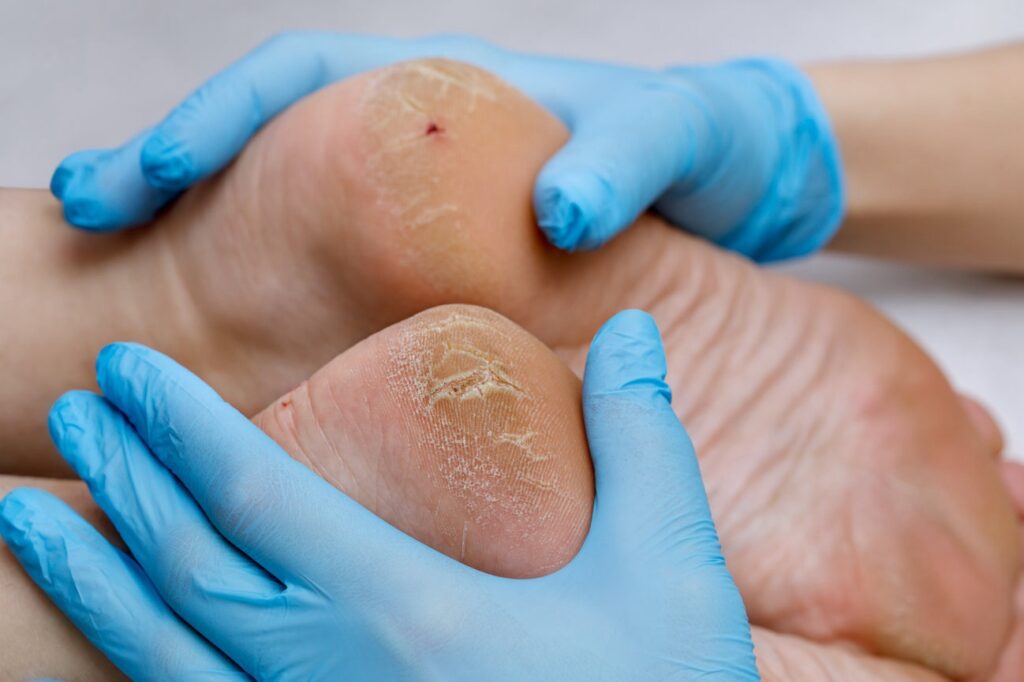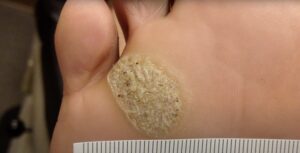Cracked heels, a prevalent foot ailment, transpire when the thick, dry skin on the bottom of your heels begins to crack and split. This condition is more than just an aesthetic issue; it’s a lingering problem that can affect your comfort and foot health.
Typically, when the cracks are minor, the condition can be quite bearable, merely causing a degree of inconvenience and a visible concern that might affect your confidence. However, underestimating this problem and leaving it unattended could lead to more serious complications.
If heel fissures continue to deepen without proper care, they become more than just an unappealing sight. The situation can quickly escalate to making every step an ordeal due to the deepening pain and possible infections. This problem is not only an issue related to physical appearance but impacts basic daily activities.
Key Questions Addressed in this Article:
- What are the causes of cracked heels?;
- What are the symptoms associated with cracked heels?;
- How can cracked heels be effectively treated?;
- What are the risks of ignoring cracked heels?;
- What preventive measures can be taken to avoid cracked heels?
Decoding the Causes and Risk Factors
Cracked heels are not a spontaneous occurrence. There are specific stages leading to this foot ailment. In the initial stage, the skin around the heel hardens and turns dry, forming calluses. These calluses endure the pressure of your weight as you walk, causing the fat pads beneath your heels to expand. This expansion triggers the cracks in the calluses.
In addition to the above, other contributing factors to the formation of cracked heels include:
- Prolonged standing, particularly on hard surfaces;
- Unsuitable footwear that lacks support, such as open-back shoes or flip-flops;
- Habitual barefoot walking, which leaves your feet devoid of necessary support;
- Excessive weight or obesity, which puts additional strain on the heels;
- Frequent indulgence in long, hot showers or baths that dry out the skin;
- Chronic medical conditions, notably diabetes.
Over time, the cracks on the heels deepen, eventually leading to bleeding in extreme cases. This can pave the way for infections. For individuals with diabetes, cracked heels pose a significant risk. They can escalate to diabetic foot ulcerations, a severe complication that necessitates immediate medical attention.
Spotting the Signs: Symptoms of Cracked Heels
Cracked heels don’t just manifest in the form of fissured, dry skin. The issue is often accompanied by a set of distinct symptoms:
- Pain or discomfort, typically heightened during standing or walking;
- Itching in the affected area;
- Bleeding from deep cracks;
- Skin shedding or flaking;
- Redness, warmth, and swelling indicate an infection.
Understanding these signs helps you gauge the severity of your problem and identify the most effective treatment course.
Healing the Heels: Effective Treatments
As common as cracked heels may be, their treatment often centers around some basic skincare principles. The same way you rely on a good moisturizer to keep your skin supple and healthy, the key to healing cracked heels lies in hydrating and softening the skin.
If your cracked heels are a minor problem, moisturizing your heels diligently 2-3 times a day can bring noticeable relief. Before moisturizing, use a pumice stone to exfoliate any hard, dead skin that could hinder the moisturizer’s absorption.
If your symptoms persist even after a week of routine foot care, it’s time to seek professional help. A trained podiatrist can recommend or administer a multitude of treatments:
- Mechanical debridement: This involves the careful removal of thick calluses or fissures using a scalpel blade, reducing skin buildup and pressure on the heels;
- Dermal foot balm: Unlike conventional moisturizers, these balms contain urea, boosting their effectiveness in skin hydration and nourishment;
- Appropriate footwear: This involves wearing shoes that provide good cushioning to the heel pads, preventing callus buildup;
- Foot and ankle strapping: This involves the use of bandages or dressings around the heel to limit skin movement and prevent cracking.
Furthermore, a podiatrist can perform pressure assessments. This advanced technology identifies the amount of pressure your heel endures as you walk, allowing your healthcare provider to devise strategies to minimize this pressure and prevent callus buildup.
The Consequences of Unattended Cracked Heels
Neglecting cracked heels may initially seem inconsequential, but over time, the fallout from this oversight becomes more apparent and troubling:
- Continual discomfort and pain can lead to frequent requirements of debridement procedures;
- The cracks can intensify, causing not only further pain but also dreaded bleeding;
- The open wounds from the deepened cracks can invite bacterial invasion, leading to a skin infection known as cellulitis;
- For those with diabetes, the predicament is more severe. The persistent and deepening cracks can eventually lead to diabetic foot ulcers.
Ignoring cracked heels is not an avenue worth exploring. Taking immediate action is crucial to prevent these complications.

Prevention: The Proactive Path to Curbing Cracked Heels
Taking preventive measures is your best bet in steering clear of the discomfort and potential complications of cracked heels. Follow the recommendations below to maintain smooth, healthy heels:
- Hydrate the Skin: Regular application of a thick, urea-based moisturizer can keep your skin nourished and prevent dryness, a major contributor to cracked heels. Remember to avoid applying moisturizer between the toes to prevent fungal infections;
- Regular Foot Inspection: Make a habit of examining your feet daily to pick up on any early warning signs of developing cracks;
- Suitable Footwear: Always opt for supportive, good-quality shoes that don’t contribute to dry skin. Open-back sandals, thongs, and bare feet fail to provide the necessary support, resulting in hardened skin and subsequently cracked heels;
- Stockings and Socks: Encase your feet in stockings and high-quality socks whenever possible. These provide an extra layer of protection, keeping your feet moist and reducing the chances of dryness and cracking;
- Limit Standing: Avoid prolonged periods of standing, especially on hard surfaces, as this can increase pressure on your feet and lead to cracked heels;
- Hydrate: Drink ample amounts of water daily. Dehydration can dry out your skin, making you more susceptible to cracked heels.
Conclusion
Cracked heels, a common foot ailment, often get overlooked due to their seemingly benign nature. However, if left untreated, they can escalate into painful and potentially dangerous conditions, including infections, leg pain and foot ulcerations, particularly in diabetics. Therefore, implementing preventative measures like daily foot inspection, proper hydration, and use of appropriate footwear is crucial. Additionally, maintaining efficient foot care, such as regular moisturization and avoiding prolonged standing, can help keep cracked heels at bay. Remember—taking timely action and adopting healthy foot care habits is key to maintaining foot health and overall well-being.


